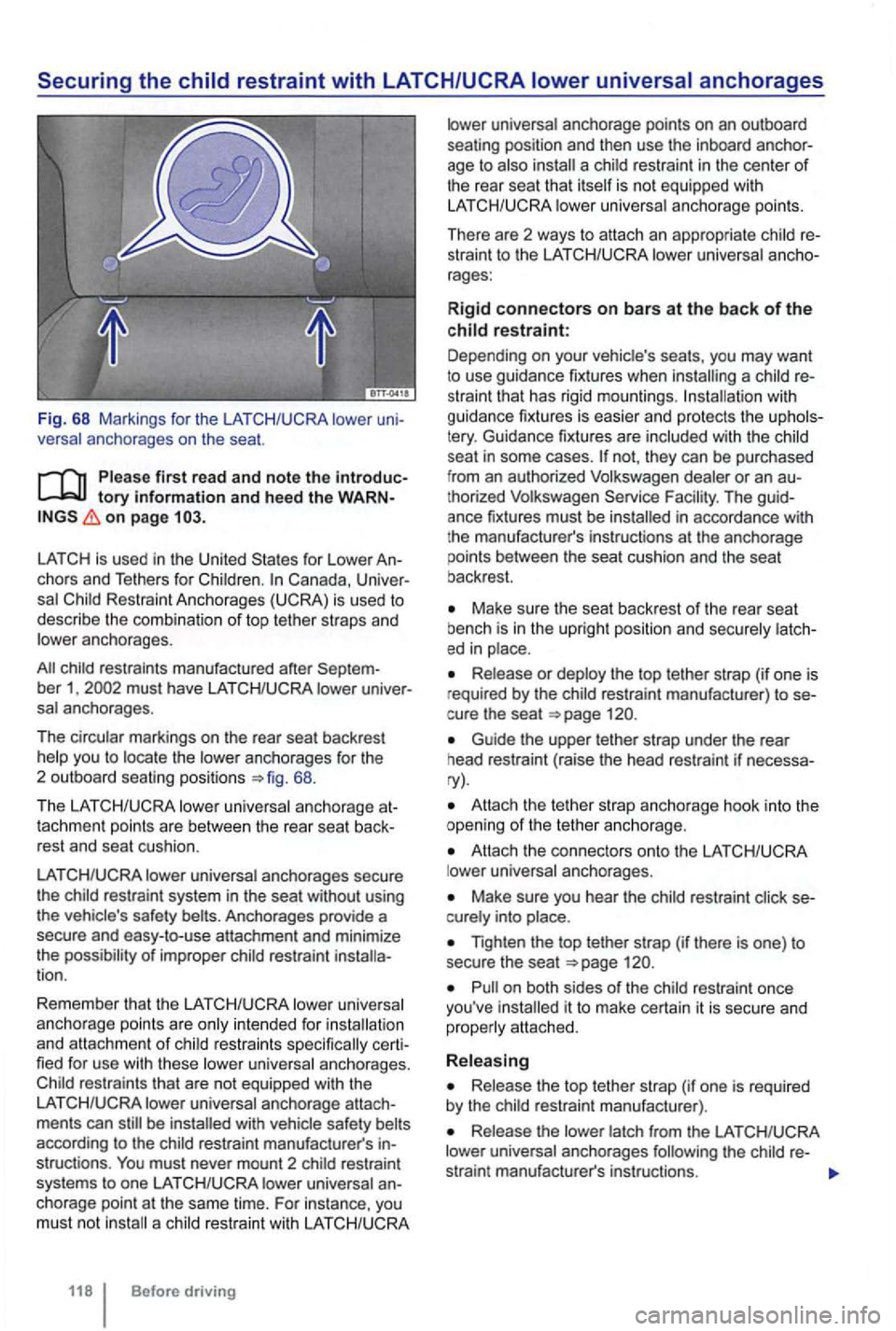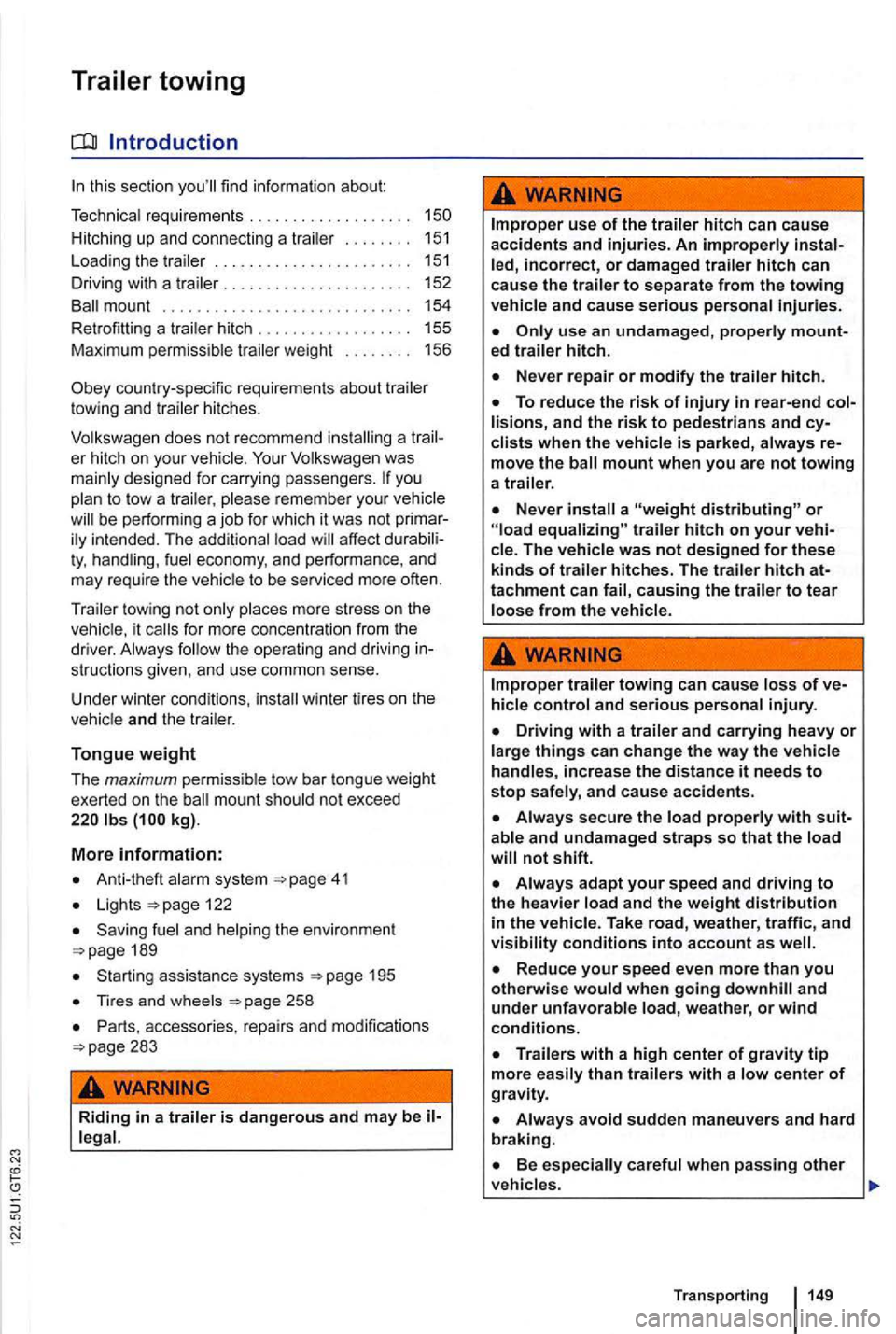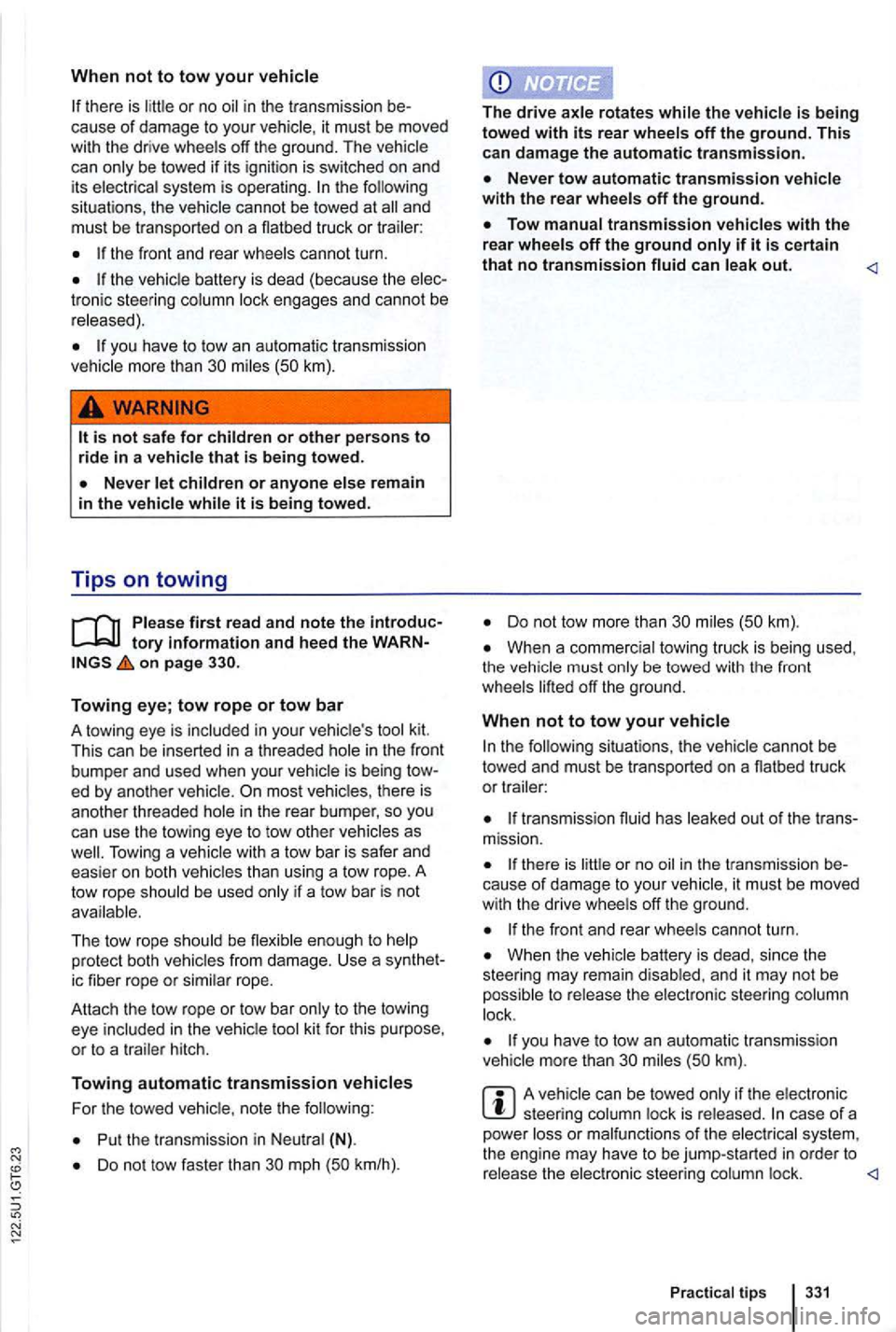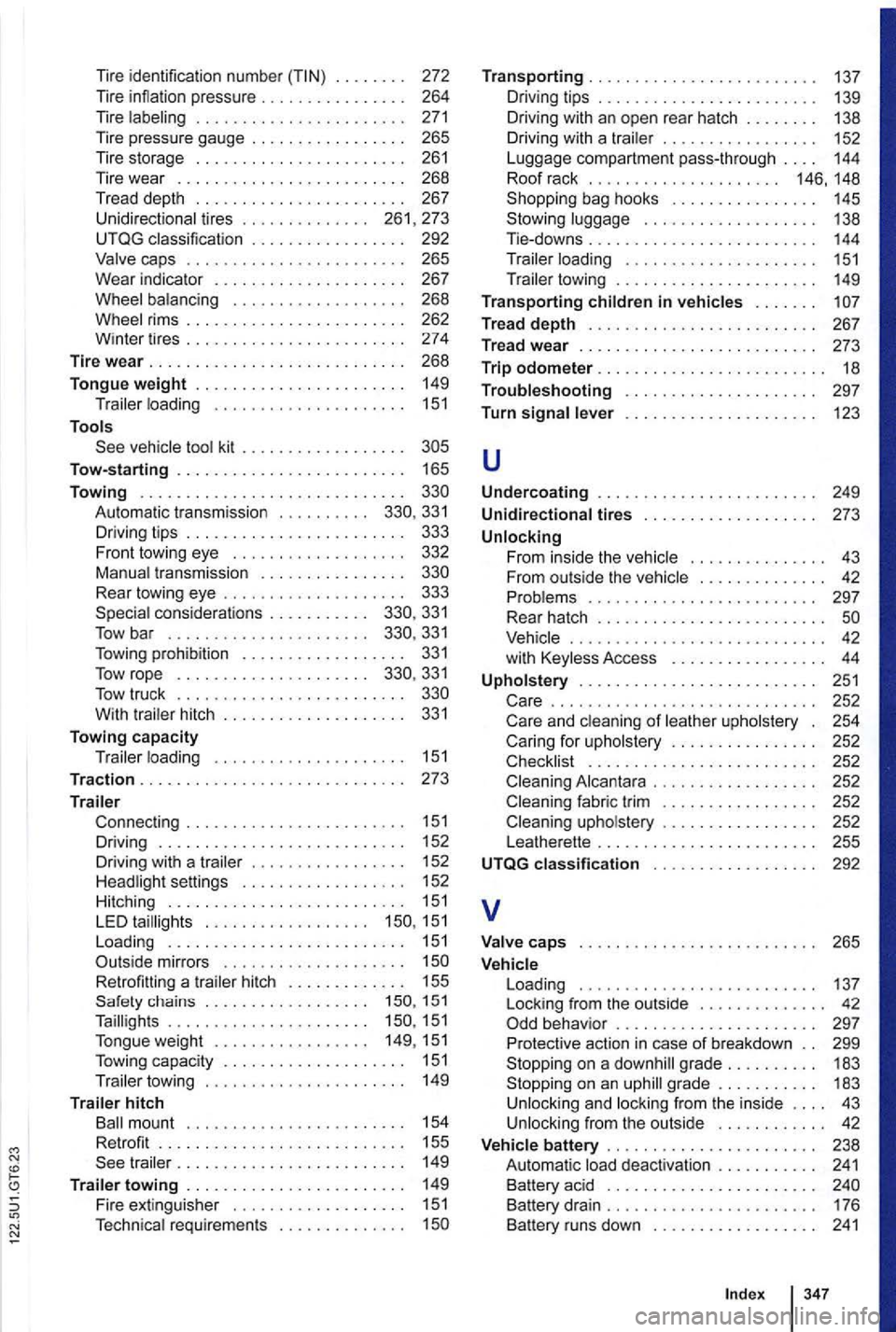2010 VOLKSWAGEN GOLF tow bar
[x] Cancel search: tow barPage 217 of 516

Fig. 68 Markings for the anchorages on t he seat.
tory information and heed the WARNon page
for Lowe r An
cho rs and Tethers for Canada, UniverRestrai nt A nchorages (UCRA) is used to
describ e the combina tion of top tether straps and
l ower an chorages .
lower univeranchorages.
T he circular markings
on the rear seat backrest you to the lowe r anchorages for the 2 outboard seating posit ions 68.
The anchorage at
t ach men t poi nts are between the rear seat back
re st and seat cu shion .
universal anchorages secure
th e child restraint system in the seat without using
th e vehicle's safety
of improper restraint tion.
Remember th at the
ancho ra ge poin ts are int end ed for insta llat ion
and attachme nt of restraint s speci fically certi
fied for use with these anchorages.
be
restraint
systems to one an
c hora ge point at the same time. For instance , you
must not
Befo re driving
anchorage points .
T here are 2 ways to attach an appropr iate
re
straint to the anc ho
rages :
Rigid connectors on bars at the back of the child restraint:
Depending on your vehic le's sea ts, you may want to use guidance fixtures when with
guidance fixtures is easier and protects the
tery. Guidance fixtures are with the not, they can be purchased
f rom an authorized Volkswagen or an au
t horized Volkswagen Service Facility. The guid
ance fixtures mu
st be in acco rdance with
t h e manufactu rer's instructions at th e anchorage
po ints between the sea t cush ion and the seat
bac krest.
Make sure the seat backre st of the rear seat bench i s in the upright position and securely latch
ed in place.
or restraint manufacturer) to se
cu re the seat
Guide the upper tether strap under the rear
h ead restraint (raise the head restrain t if necessa
ry).
Attach the tether strap ancho rage hook into the
open ing of the te ther an ch orage.
Attach the connectors onto the tower universal anchorages.
Make sure you hear the restraint seinto
it to make certain it is secure and
Release the top tethe r strap (if one is requi red
by the rest raint manufacturer) .
the re-
straint manufacturer's instructi ons.
Page 248 of 516

Introduction
this section
..
L oading the trailer
.............. ........ .
Driving with a trailer ..... . .. .. ........... .
mount .... . .
Retrofitting a trai l
er hitch ................ .
Max imum permissible trailer weight ... . 150
151
151
152
154
155
156
for
more concentratio n from the
dr iver . Always the ope rat ing and driving in
stru ctions given , and use common sense.
Un der winter conditions ,
win ter tires on the
vehicle and the trailer.
Tongue weight
The m aximum permissible tow bar tongue weight
exerted on the mount should not exceed kg).
More information:
Anti-theft a larm system
Lights page 122
Startin g assistance systems 195
Tires and wheels page 258
Parts, accessories, repairs and modifications
Riding in a trailer is dangerous and may be il
incorrect, or damaged trailer hitch can
cause the trailer to separate from the towing vehicle and cause serious personal injuries.
use an undamaged, properly mount
ed trail er hitch.
mount when you are not towing a trailer.
properly with suitable and undamaged straps so that the not shift.
and under unfavorable weather, or wind conditions.
careful when passing other vehicles.
Transporting 149
Page 430 of 516

When not to tow your
there is in the tr ansmission be
cause of damage to you r it must be moved
with the drive wheels off the ground . The vehicle
can only be towed if its ignition is switched on and
i ts electrica l system is operating. the following
situat ions, the vehicle cannot be towed at
the front and rear whee ls can not turn .
the vehic le battery is dead {because the elec
troni c steering column lock engages and cannot be
r e leased).
you have to tow an automatic transmission
vehic le more than 30
first read and note the introduc
on page
Towing eye; tow rope or tow bar
A towing eye is included in your vehic le 's tool kit. This can be inserted in a threaded hole in the front
bumper and used when your vehicl e is being tow
ed by ano ther vehicle.
The tow rope should be flexib le enough to he lp
protect both vehicles from damage. Use a synthet
ic fiber rope or similar rope .
Attach the tow rope or tow bar only
to the towing
eye in the vehic le
For the towed vehic le, note the following :
Put the transmission in Neu tral (N) .
Do not tow faster than 30 mph (50 km/h). The
drive rotates while the i
s being towe d with its rear wheels off the ground. This can damage the automatic transmission .
can
Do not tow more than 30 miles (50 km).
When a commerc ial towing truck is being used,
the must be towed with the front
wheels
transmiss ion fluid ha s out of the trans
mission.
the re is in the transmissio n be
cause of damage to your vehicle, it must be moved
w ith the drive whee ls off the ground.
the front and rear whee ls cannot turn.
When the vehicle battery is dead , since the
steering may remain disabl ed, and it may not be
poss ib le to rele ase the electronic steering column
lock.
you have to tow an auto matic transmiss ion
veh icle mor e than 30 miles (50 km).
A veh icle can be towed only if the electronic steer ing column lock is r e leased. case of a
power system,
the engine may have to be jump-started in order to release the electronic steering column lock .
Page 446 of 516

Tire identification number . . . . . . . . 272
Tire i nflation pressure . . . . . . . . . . . . . . . . 264
Tire
. . . . 261, 273
UTQG classification . . . . . . . . . . . . . . . . . 292
Valve caps . . . . . . . . . . . . . . . . . . . . . . . . 265
Wear indicator . . . . . . . . . . . . . . . . . . . . . 267
Wheel balancing . . . . . . . . . .
. . . . . . . . 268
Wheel rims . . . . . . . . . . . . . . . . . . . . . . . . 262
Winte r tires . . . . . . . . . . . . . . . . . . . . . . . . 274
Tire wear . . . . . . . . . . . . . . . . . . . . . . . . . . . . 268
Tongue weight . . . . . . . . . . . . . . . . . . . . . . . 149
Trailer loading . . . . . . . . . . . . . . . . . . . . 151
Tools kit . . . . . . . . . . . . . . . .
Tow-starting . . . . . . . . . . . . . . . . . . . . . . . . . 165
Towing ............................. 331 Driving tips . . . . . . . . . . . . . . . . . . . . . . . . 333
Front towing eye . . . . . . . . . . . . . . . . . . . 332
Manua l tr ansmission . . . . . . . . . . . . . . . .
Rear towing eye . . . . . . . . . . . . . . . . 333 considerations . . . . . . . . . . . 331 Tow bar . . . . . . . . . . . . . . . . . . . . . . . . . . . . . . . . . . 331 Tow rope . . . . . . . . . . . . . . . . . . . . . 331 Tow truck . . . . . . . . . . . . . . . . . . . . . . . . .
. . . . . . . . . . . . . . 273
Trail er
Connec ting . . . . . . . . . . . . . . . . . . . . . . . .
151 Driving . . . . . . . . . . . . . . . . . . . . . . . . . . 152
Driving with a trailer . . . . . . . . . . . . . . . . . 152
Head
light settings . . . . . . . . . . . . . . . . . . 152
Hitching . . . . . . . . . . . . . . . . . . . . . . . . . . 151 LED taillights . . . . . . . . . . . . . . . . 151 Load ing . . . . . . . . . . . . . . . . . . . . . . . . . . 151 Ou ts ide mirrors . . . . . . . . . . . . . . . . . . . . . . . . . . . 155
Sa fety chains . . . . . . . . . . . . . . . . . 151 Ta illi gh ts . . . . . . . . . . . . . . . . . . . . . . 151 Tongue weight ................. 149,151
Towing capacity . . . . . . . . . . . . . . . . . . . . 151 Trai ler towing . . . . . . . . . . . . . . . . . . . . . . 149
hitch
. . . . . . . . . . . . . 155
Transporting . . . . . . . . . . . . . . . . . . . . . . . . 137
Driving tips . . . . . . . . . . . . . . . . . . . . . . . . 139
Driving with an open rear hatch . . . . . . . . 138
Driving with a trai ler . . . . . . . . . . . . . . . . . 152
Luggage compartment pass-thro ugh . . . . 144
Roof rack . . . . . . . . . . . . . . . . . . . . . 146, 148
Shopping bag hooks . . . . . . . . . . . . . . . . 145
Stow
ing luggage . . . . . . . . . . . . . . . . . . . 138 Tie-downs . . . . . . . . . . . . . . . . . . . . . . . . . 144
Trailer loading . . . . . . . . . . . . . . . . . . . . . 151 Trailer towing . . . . . . . . . . . . . . . . . . . . . . 149
Tran
sporting children in vehicles . . . . . . . Tread depth . . . . . . . . . . . . . . . . . . . . .
. . . . . . . . . . . . . 18 Troubleshooting . . . . . . . . . . . . . . . . . . . 297
T urn s
ignal leve r . . . . . . . . . . . . . . . . . . . . . 123
u
Undercoating ....................... . 249 Unidirectional tires . . . . . . . . . . . . . . . . . . . 273
Unlocking From inside the vehicle . . . . . . . . . . . . . . . 43
From outside the vehicle . . . . . . . . .
. . . . . . . . . . . . . . . . . . . . . . . . . . 42
wi th Keyless Access . . . . . . . . . . . . . . . . . 44
Upholstery . . . . . . . . . . . . . . . . . . . . . . . . . . 251 .......... ................... 252
. . . . . . . . . . . . 252
. . . 252
. . . 255
UTQG classification 292
v
Valve caps Vehi cle 265
L oad ing . . . . . . . . . . . . . . . . . . . . . . . . . . 1
37 Lock ing from the outside . . . . . . . . . . . . . . 42
grade . . . . . . . . . . 183 Stopping on an grade . . . . . . . . . . . 183 Unlocking and locking from the ins ide . . . . 43 U nlocking from the outside . . . . . . . . . . . . 42
Vehicle battery . . . . . . . . . . . . . . . . . . . . . . . 238
Au toma tic deact ivation . . . . . . . . . . . 241 Battery acid . . . . . . . . . . . . . . . . . . . . . . . . . . . 176
Battery runs down . . . . . . . . . . . . . . . . . . 241
347